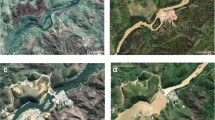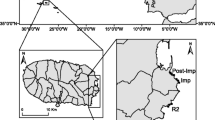Abstract
Three years' investigations of the shallow water communities at 30 different rocky shore sites in an estuary in southeast Norway were carried out during 1980–1982. The flora was mostly poor, possibly due to a combination of fresh water exposure, industrial and sewage outlets. The aim of these investigations was to establish the environmental status of the estuary prior to huge outlet reductions in 1989/90. Later reinvestigations during 1992–1994, following a significant reduction of titanium dioxide wastes and building of a new chemical sewage treatment plant have shown an improvement of the macroalgal and benthic animal communities. In the formerly most polluted area, the number of benthic taxa has increased since 1980–1982 by 50–350% in 1992–1994.
Similar content being viewed by others
References
Baden, S. P., L. O. Loo, L. Pihl & R. Rosenberg, 1990. Effects of eutrophication on benthic communities including fish: Swedish west coast. Ambio 19: 113–122.
Bokn, T.,1979. Use of benthic algae classes as indicators for eutrophication in estuarine and marine waters. In H. Hytteborn (ed.) The use of ecological variables in environmental monitoring. Naturvårdsverket, report 1151.
Bokn, T., 1984. Basisundersøkelser i Hvalerområdet og Singlefjorden. Gruntvannsorganismer 1980–1982. Statlig program for forurensningsovervåking. Report 135/84. NIVA-report. Serial No. 1615,49 pp.
Bokn, T., 1990. Effects of acid wastes from titanium dioxide production on biomass and species richness of benthic algae. Hydrobiologia/Dev. Hydrobiol. 204/205: 197–203.
Bokn, T., J. Knutzen & B. Rygg, 1976. Influence of freshwater, industrial waste and domestic sewage on bottom fauna and benthic algae in the Hvaler Archipelago (S.E. Norway). In S. Skreslet et al. (eds) Fresh Water on the Sea: 211–220. The Association of Norwegian Oceanographers, Oslo, 246 pp.
Bokn, T., L. Kirkerud, K. Kvalvågnæs & B. Rygg, 1977. Resipientundersøkelse av nedre Skienselva, Frierfjorden og tilliggende fjordområder. Report No. 6. Fremdriftsrapport fra de biologiske undersøkelsene mars 1974 – mai 1976. NIVA-report/O-70111, 234 pp.
Bokn, T. L., S. N. Murray, F. E. Moy & J. B. Magnusson, 1992. Changes in fucoid distributions and abundances in the inner Oslofjord, Norway: 1974–80 versus 1988–90. Acta Phytogeogr. Suec. 78: 117–124.
Cederwall, H. & R. Elmgren, 1990. Biological effects of eutrophication in the Baltic Sea, particularly the coastal zone. Ambio 19: 109–112.
Christensen, M. E., 1969. Crustacea Decapoda Brachuyra. Marine Invertebrates of Scandinavia no. 2. Universitetsforlaget, Oslo, 143 pp.
Clarke, K. R. 1993. Non-parametric multivariate analyses of changes in community structure. Aust. J. Ecol. 18: 117–143.
Grenager, B., 1957. Algological observations from the polluted area of Oslofjord. Nytt. Mag. Bot. 5: 41–60.
Hardy, F G., S. M. Evans & M. A. Tremayne, 1993. Long-term changes in the marine macroalgae of three polluted estuaries in the north-east England. J. exp. mar. Biol. Ecol. 172: 81–92.
Ibrekk, H. 0., 1989. Tilførsler av næringssalter til kystområder i Norge. VANN No. 3, 1989: 343–351.
Jones, W.E., A. Fletcher, S. Bennell, B. McConnell & S.M. Smith, 1979. Changes in littoral populations as recorded by long term shore surveillance. 1. Selected examples of cyclic changes. - In E. Naylor & R. G. Hartnoll (eds), Cyclic phenomena in marine plants and animals. Pergamon Press, Oxford: 93–100.
Kautsky, H., L. Kautsky, N. Kautsky, U. Kautsky & C. Lindblad, 1992. Studies on the Fucus vesiculosus community in the Baltic Sea. Acta Phytogeogr. Suec. 78: 33–48.
Kautsky, N. 1982. Growth and size structure in a Baltic Mytilus edulis population. Mar. Biol. 68: 117–133.
Kautsky, N., H. Kautsky, U. Kautsky & M. Warn, 1986. Decreased depth penetration of Fucus vesiculosus since the 1940's indicates eutrophication of the Baltic Sea. Mar. Ecol. Prog. Ser. 28: 1–8.
Klavestad, N., 1978. The marine algae of the polluted inner part of the Oslofjord. A survey carried out 1962–1966. Bot. mar. 21: 71–97.
Knutzen, J., 1983. A review of the effects on aquatic ecosystems of acid iron waste from the production of titanium dioxide by the sulphate process. Norw. Inst. Wat. Res. NIVA, Oslo. Serial No. 1458, 72 pp.
Munda, I. M., 1993. Changes and degradation of seaweed stands in the Northern Adriatic. Hydrobiologia/Dev.Hydrobiol. 260/261: 239–253.
Murray, S. N. & M. M. Littler, 1984. Analysis of seaweed communities in a disturbed rocky intertidal environment near Whites Point, Los Angeles, California, U.S.A. Hydrobiologia/Dev.Hydrobiol. 116/117: 374–382.
Oviatt, C. A., J. G. Quinn, J. T. Maughan, J. T. Ellis, B. K. Sullivan, J. G. Gearing, C. D. Hunt, P. A. Sampou & J. S. Latimer, 1987. Fate and effects of sewage sludge in the coastal marine environment: a mesocosm experiment. Mar. Ecol. 41: 187–203.
Rueness, J., 1973. Pollution effects on littoral algal communities in the inner Oslofjord, with special reference to Ascophyllum nodosum. Helgoländer wiss. Meeresunters. 24: 446–454.
Seapy, R. R. & M. M. Littler, 1982. Population and species diversity fluctuations in a rocky intertidal community relative to severe aerial exposure and sediment burial. Mar. Biol. 71: 87–96.
Seed, R. & T. H. Suchanek. 1992. Population and community ecology of Mytilus. In E. Gosling (ed.), The mussel Mytilus: Ecology, physiology, genetics and culture. Developments in aquaculture and fisheries science, 25. Elsevier, Amsterdam, 589 pp.
Smith, R. W., B. B. Bernstein & R. L. Cimberg, 1990. Community — environmental relationships in the benthos: applications of multivariate analytical techniques. In D. F. Soule & G. S. Kleppel (eds), Marine organisms as indicators. Springer-Verlag, New York, 247–326.
Sundene, O., 1953. The algal vegetation of Oslofjord. - Skr. Nor. Vidensk. Akad. I. Mat. Nat. KI 1953, 2: 1–245.
Vogt, H. & W. Schramm, 1991. Conspicuous decline of Fucus in Kiel Bay (Western Baltic): what are the causes? Mar. Ecol. Prog. Ser. 69: 189–194.
von Wachenfeldt, T., 1975. Marine benthic algae and the environment in the Öresund. I–III. Thesis. Lund Univ, 328 pp.
Warwick, R. M. 1993. Environmental impact studies on marine communities: pragmatical considerations. Aust. J. Ecol. 18: 63–80.
Wennberg, T., 1992. Colonization and succession of macroalgae on a breakwater in Laholm Bay, a eutrophicated brackish water area (SW SWEDEN). Acta Phytogeogr. Suec. 78: 65–77.
Author information
Authors and Affiliations
Rights and permissions
About this article
Cite this article
Bokn, T.L., Moy, F.E. & Walday, M. Improvement of the shallow water communities following reductions of industrial outlets and sewage discharge in the Hvaler estuary, Norway. Hydrobiologia 326, 297–304 (1996). https://doi.org/10.1007/BF00047822
Issue Date:
DOI: https://doi.org/10.1007/BF00047822




